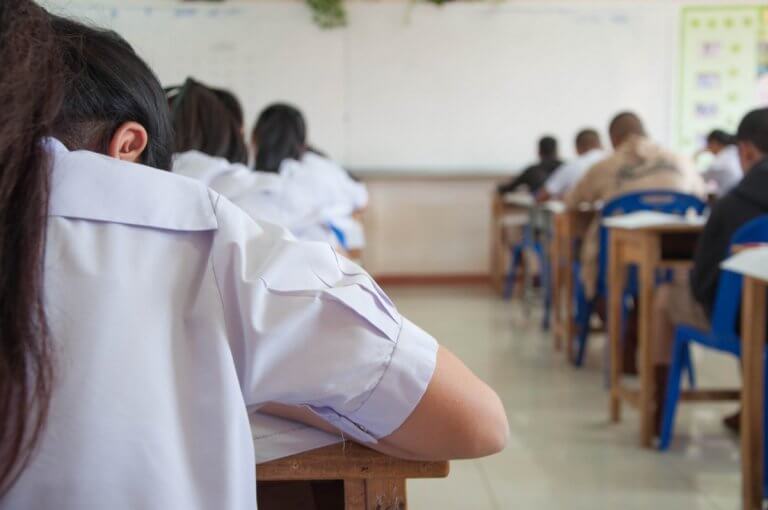
Streaming (or ‘tracking’, as it is also known) students in schools involves separating students into classes based on their intellectual or academic ability.
Depending on the school’s practice, students typically stay in that class for a year and may change classes the following year based on their year-end assessments.
However, despite its popularity, this practice remains hotly debated in some circles.
Advocates claim it helps students learn with others of similar abilities so learning can be done at the same pace; this purportedly prevents weaker students from losing confidence and motivation if they are slower than their peers to grasp new concepts.
Meanwhile, streaming allows teachers to apply the same pace of teaching with everyone within the classroom without fear of leaving anyone behind. This promotes healthy competition and encourages students to work harder to remain in the top class, or to work their way upwards if they are in a lower class.
Conversely, critics assert that this practice benefits teachers more than they do students as it makes classroom management easier for educators rather than focusing on helping pupils with their education. Students also risk being labelled as “smart” or “dumb”, depending on the class they’ve been streamed into, and this label may stick with them long into the future and affect their confidence.
But is streaming as good or bad as people seem to think it is, or is the answer less clear cut?
What the research says
This international literature review about streaming and its effects on the learning outcomes for secondary school students finds that generally streaming has a negative impact. It is free to read in @AusJournalEd in June https://t.co/HPj9lHbTyr
— AJE (@AusJournalEd) June 6, 2018
Research into streaming has yielded mixed results, with some suggesting that streaming only benefits a cadre of students, while others suggest otherwise.
Researchers at the UCL Institute of Education (IOE) have found that “on average, ‘setting or streaming’ – where pupils with similar levels of current attainment are grouped together for lessons – is unlikely to boost learning for all pupils.
“However, ‘within-class attainment grouping’ – where pupils with similar current attainment are grouped together for specific activities within their usual class and with their usual teacher – can lead to average gains of around three additional months’ progress per year.
“However, lower attaining pupils appear to benefit less from this approach than their classmates,” the report said.
Meanwhile, an international literature review about streaming and the effects of this practice on the learning outcomes for secondary school students in Australia noted: “While research is contentious and often contested, the literature generally shows that streaming impacts negatively on student learning outcomes.”
In Malaysia, researchers found that both teachers’ and students’ agree that the benefits of streaming outweigh its disadvantages. Teachers felt that streaming enables them to provide standardised lesson planning and “reduced peer pressure that facilitates students to set achievable goals and increase motivation”.
Conversely, streaming presents a culture that “excludes inter-ability socialisation of students according to academic ability and (an) overemphasis on exam orientation, resulting in low self-esteem and achievement motivation.”
In Zimbabwe, researchers who studied streaming in secondary schools made several conclusions, including:
- “Streaming promotes competition amongst pupils in both the top stream classes and the lower stream classes”
- “Lower stream pupils felt it was easier to work with pupils with same ability range as they assisted each other and did not rebuke each other when they made mistakes”
- “Pupils from the top streams thought that streaming brought about positive competition amongst the learners which helped them to work harder in their school work”
- “The top stream pupils also felt that streaming promoted polarisation between top stream and lower stream learners”
While streaming may stem from good intentions to help students succeed in school, it’s clear from research that issues can arise from this practice, such as negatively affecting a students’ self-worth in some instances.
What do educators think about it?
Prof John Hattie calls for schools to stop streaming students in @nzherald https://t.co/ve7s12yQ6l #edchat
— MGSE (@EduMelb) March 19, 2017
In an email interview with three educators, all three generally agree that students should not be streamed in schools.
“In theory, the practice (of tracking) ensured all students received quality instruction and could learn at a rate that was comfortable for them.
“Unfortunately, in my opinion, the practice did more harm than good,” said Joseph Fatheree, an Instructor of Creativity and Innovation at Effingham High School in Effingham, Illinois, US.
One reason, Fatheree said, was because it was “next to impossible” for a student to move up to the next level.
“Once students are placed in a track, they typically stay there. Students that were assigned to the lowest track were condemned to live there for perpetuity,” he said.
The impact on students stuck in the lower track? Low self-confidence.
“It is a stigma that many of them have carried for their entire lives,” he said.
But it doesn’t just affect the lower-track students. It’s also middle-level track students who suffer from not being good enough to be in higher tracks, and Fatheree notes that a student’s mental and social-emotional health is just as important as academics.
“Unfortunately, most schools focus entirely on academics while ignoring the needs of the whole child. Tracking can lead to that,” said the Top 10 Finalist of the 2016 Global Teacher Prize by the Varkey Foundation.
Fatheree also poured doubt on the viability of the tracking or streaming process itself, saying the system doesn’t always place students in the correct ability segments. In many cases, he said, the lower-level classes became dumping grounds for students suffering disciplinary problems. Little to no focus is given to the students’ actual learning needs and abilities.
“Tracking creates a series of silos that separate students into groups that are based almost entirely on academic performance. Because of this, students may never have the opportunity to take a class with a student from another track.
“As a direct result they have little understanding of the struggles other students have or what success looks like to different students,” he explained.
Student “streaming” in high school should be phased out, urges report to Toronto trustees: http://t.co/TRWwNBkjmE pic.twitter.com/ickRyzBRWs
— Jean-Paul Boudreau (@Boudreau_Ideas) October 11, 2015
While Noorjahan Sultan, who teaches preschool and Year 1 students in Malaysia, agrees that streaming should be avoided in schools, she notes that this is more practical for younger learners as opposed to older students.
Noorjahan, who was in the Top 50 Finalist of the 2016 Global Teacher Prize, said there are fast learners and late bloomers in every class, and that by not streaming students, there will be a “healthy connection” between the two.
Meanwhile, she noted that teaching in a mixed ability class also encourages teachers to be more creative and innovative in their approach, while students can benefit by making friends with students of all levels. Academically-inclined students can develop a sense of responsibility and kindness in the process of assisting peers who need help with their studies, in addition to acting as a source of motivation to help slower students excel.
Vanesri Kasi, who teaches both remedial and mainstream students at primary level in Malaysia, said non-streaming encourages teachers to plan collaborative activities for their students, making it an inclusive environment for them to learn in, in addition to encouraging teachers to treat their students equally.
Vanesri, who was also shortlisted for the 2016 Global Teacher Prize, explained that this practice can provide students with an equal opportunity to make friends with students of all academic levels, in addition to acting as a platform where students can learn from each other and in ensuring that all students attain the same level of knowledge.
When students are treated equally with others, they are likelier to come to school happy, she notes.
Liked this? Then you’ll love…
Here’s how technology is shaping the future of education
Is social and emotional learning a springboard for student success?







